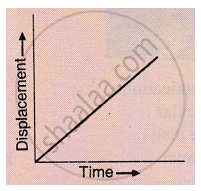Advertisements
Advertisements
Question
For a uniformly retarded motion, the velocity-time graph is _____________
Options
A curve
A straight line parallel to the time axis
A straight line perpendicular to the time axis
A straight line inclined to the time axis
Solution
For a uniformly retarded motion, the velocity-time graph is A straight line inclined to the time axis.
APPEARS IN
RELATED QUESTIONS
A train starting from a railway station and moving with uniform acceleration attains a speed 40 km h−1 in 10 minutes. Find its acceleration.
Give one example of a situation in which a body has a certain average speed but its average velocity is zero.
What is meant by the term acceleration ? State the SI unit of acceleration.
What conclusion can you draw about the velocity of a body from the displacement-time graph shown below :

Find the initial velocity of a car which is stopped in 10 seconds by applying brakes. The retardation due to brakes is 2.5 m/s2.
A boy is sitting on a merry-go-round which is moving with a constant speed of 10 m s−1. This means that the boy is :
A bus increases its speed from 36 km/h to 72 km/h in 10 seconds. Its acceleration is :
Differentiate between uniform acceleration and variable acceleration.
How can you find the following?
Acceleration from velocity – time graph.
An electron moving with a velocity of 5 × 104 ms−1 enters into a uniform electric field and acquires a uniform acceleration of 104 ms–2 in the direction of its initial motion.
(i) Calculate the time in which the electron would acquire a velocity double of its initial velocity.
(ii) How much distance the electron would cover at this time?
